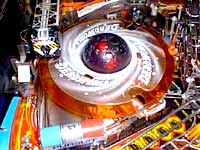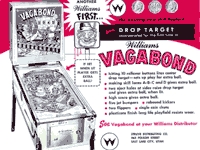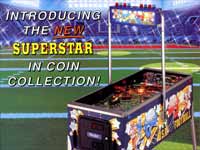The flipping, bouncing, bumping, leisure love machine
Pinball machines: a byword for the life of leisure, an aimless distraction for teenagers and slackers everywhere. And, along with darts and pool, the best way to sharpen reflexes while smoking and/or drinking.
 Interactive surround-sound video games like Daytona and Alpine Racer may be all the rage among the Console Generation, but the simple pleasures of pinball are still a big drawcard in arcade land.
Interactive surround-sound video games like Daytona and Alpine Racer may be all the rage among the Console Generation, but the simple pleasures of pinball are still a big drawcard in arcade land.
Indeed, the pinball industry has argably guaranteed its long-term survival not by fighting new technologies, but by incorporating advanced gadgetry into the decades-old pinball concept.
�Improved bagatelle�
Evolved from the much older game of bagatelle, which was played from one end of a narrow billiards table, the first recognisable pinball device was patented - as �improved bagatelle� - in 1871 by one Montague Redgrave.
| FROM THE ARCHIVES ...
 Eureka! hosts Sarah Greene and Paul McDowell explain the history of pinball Eureka! hosts Sarah Greene and Paul McDowell explain the history of pinball
- Eureka!, 1983
 Despite Mayor La Guardia's attempt to ban the game, the silver ball lives on - from Soho down to Brighton Despite Mayor La Guardia's attempt to ban the game, the silver ball lives on - from Soho down to Brighton
- Eureka!, 1983 (RealVideo)
|
Within a decade, the essential features of pinball - a table angled towards the player, pins to trap the ball and a spring-loaded mechanism to launch the ball - were in place. The term �pinball� seems to date to around 1936.
Overcoming Depression
The first successful mass-produced pinball game was �Ballyhoo�, released in 1931 by the Bally Pinball Company founded by Chicago businessman Raymond Maloney. The game was an instant hit in the Depression-era United States, providing cheap entertainment for the unemployed masses - and a quick coin-grabbing business for some shady business operators.
In 1932 the Hercules Novelty Company introduced a game called �Double Shuffle�. This was the first game with a primitive form of �flippers�, an innovation some pinball historians have called "the single greatest invention in the history of pinball".
 Lever-operated flippers introduced the element of skill that was lacking in previous incarnations - a useful counter-argument to politicians and moralisers who claimed pinball was a front for gambling.
Lever-operated flippers introduced the element of skill that was lacking in previous incarnations - a useful counter-argument to politicians and moralisers who claimed pinball was a front for gambling.
The spectre of gambling hung heavily over the pinball industry, which was widely suspected of being a front for organised crime. So serious was the threat that on January 21, 1942 a blanket ban on the game was imposed in New York City. Mayor Fiorello La Guardia inaugurated the ban with an Eliot Ness-style raid of smashing up pinball tables. Incredibly, the New York ban lasted until 1976.
Booming babies
After the Second World War, pinball began to spread among the Baby Boomer generation, which was blessed with abundant leisure time.
In 1947 Bally devised a game called �Nudgy� which allowed players to simulate "gunching" - moving the whole playing surface about, which was previously done by surreptitiously lifting and shaking the table. To combat this practice, manufacturers once considered putting sharp nails underneath their machines before settling on a tilt mechanism to prevent abuse - a feature that remains, albeit in more sophisticated form, on modern day machines.
 The following year, a company called Genco, came out with �Triple Action�, which deployed flippers in their classic modern form at the base of the table. �Triple Action� flippers were facing out rather than in, which made ball control a little suspect. Another pinball pioneer, the Gottleib Company, switched the configuration in the 1950 game �Spot Bowler�.
The following year, a company called Genco, came out with �Triple Action�, which deployed flippers in their classic modern form at the base of the table. �Triple Action� flippers were facing out rather than in, which made ball control a little suspect. Another pinball pioneer, the Gottleib Company, switched the configuration in the 1950 game �Spot Bowler�.
Bumpers to shunt the ball out of holes were another important technology that made pinball more exciting. Other key inventions include:
- Drop targets, introduced in 1962 in �Vagabond�;
- Zipper flippers, which helped an achieving player by preventing the ball from siphoning out - first used in Bally�s 1965 game �Bazaar�;
- Talking games, introduced in 1979 in �Gorgar�;
- Magnets to save balls, introduced in the early 1980s with �Black Knight�;
- Dot matrix displays, first used in the 1991 classic �Checkpoint�; and
- Switch flippers, which allowed end-to-end games or extra unpredictability in single-player mode. First introduced in Alvin Gottlieb�s 1992 games �A.G. Soccer Ball� and �USA Football�, switch flippers could also operate in �auto-flip mode�, enabling the pinball to play itself and attract business when unoccupied.
Surviving in a digital arcade
Pinball�s paramount achievement in recent times lies in the fact that it has not been subsumed by the larger video games industry.
 Clever tie-in promotions with major movies help to sustain the excitement, but pinball makers have also been quick to latch onto new technologies like microprocessors and better graphics.
Clever tie-in promotions with major movies help to sustain the excitement, but pinball makers have also been quick to latch onto new technologies like microprocessors and better graphics.
At their best, pinball machines are works of art that reflect the tastes and styles of each succeeding era. Collecting classic tables is now a serious hobby, but the simple beauty of pinball - and handy placement in pubs, arcades and cafes - continues to draw new generations of pinball devotees.
